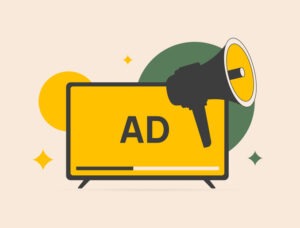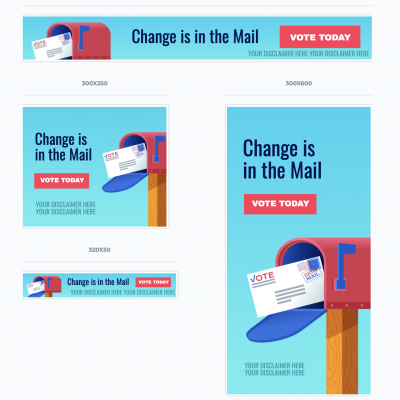The world of digital advertising throws around a lot of jargon. There is a constant flow of acronyms, technical terms, and insider language that can be overwhelming to anyone outside this landscape looking to either get involved in or manage digital strategy for a campaign. So, in this series, we’ll break down a few digital terms each week and explain to you – in layman’s terms – what they mean and why they matter to your campaign. So let’s give it a go!
Banner Ads
Also commonly called ‘Display Ads,’ these are advertisements you see on websites throughout the internet. They can either be static or animated, and are embedded into a website. Banner ads are typically found in specific sizes, and each size corresponds to a specific placement on a webpage. For example, you may see a long narrow shaped ad (728×90 pixels) on the top of a webpage and a more square-like ad (300×250 pixels) between paragraphs of a news story. These ads are clickable, so a voter can see your ad, click on it, and then be taken to the webpage of your choice.
What does this mean for your campaign?
Many campaigns choose to have banner ads up and served to their voters at all times. It is relatively easy to start new ad campaigns, and it is a great way to strategically target voters with specialized creative designs showing endorsements or policy positions that may be meaningful to them. We also have clients who pair their digital strategy with their organizing work to ensure the message their voters see online is the same one that is coming to their doors from canvassers. It’s also a great way to speak directly to your voters without needing to manage anything on a day-to-day basis.
Are these the ads I see on Facebook or Google?
While ads that appear on Facebook and Google meet many of the specificities of banner ads, they are actually separate from what the digital world typically thinks of as banner ads. Both companies – and their subsidiaries – have separate systems for online advertising. Ads that are placed as banner ads are not on Facebook or Google. Facebook ads won’t be seen outside the walls of Facebook, and Google ads won’t be seen outside the walls of Google.
Pro-tip: If you’re looking for a way to bridge the gap between Facebook ads and banner ads, check out how you can get your banner ads one step off Facebook.
Resizing banner ads
Because banner ads need to fit into specific spots (typically referred to in the industry as ‘inventory’) on the internet, an ad with a specific design is often resized into 3 or more other sizes so it has more flexibility to be placed in front of viewers. At SpeakEasy, each of our templates come in 4 different sizes, and each of these can be delivered on either mobile devices, computers/tablets, or both.
What does this mean for your campaign?
For any ad you launch, it is best practice to have this ad resized into at least 3 other sizes, most notably the 300×250 pixel size. If you only have a single size to serve, it is more difficult to deliver that ad to your voters because they will need to be browsing on a webpage with that specific size available, and many other companies, campaigns, and organizations are also fighting for that space. That’s why we highly encourage anyone using our templates to ensure their set of ads is complete in all 4 sizes. See how the image below is the same ad, but in different shapes and sizes? That’ll ensure we can get as many eyes on your ad as possible.





